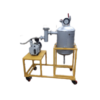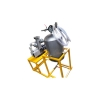Principle
The principle of a filtration unit is based on the concept of mechanical separation where a porous medium is used to separate solid particles from a liquid or gas. The process is driven by either a pressure gradient or vacuum force, allowing the liquid (or gas) to pass through the filter medium while retaining the solid particles on its surface or within its pores.
Key Principles of Filtration:
- Filtration Medium:
- The filter medium (such as filter paper, membranes, or porous materials) acts as a physical barrier that allows fluids to pass while capturing solid particles based on their particle size and the pore size of the filter medium.
- Driving Force:
- The process relies on creating a driving force that moves the fluid through the filter. This can be achieved by:
- Vacuum Filtration: A vacuum pump creates a low-pressure zone on the downstream side of the filter, pulling the liquid through the filter.
- Pressure Filtration: Positive pressure is applied on the upstream side of the filter, pushing the fluid through the medium.
- Gravity Filtration: In some setups, gravity alone is sufficient to drive the liquid through the filter.
- Retention of Particles:
- The solid particles are too large to pass through the pores of the filter medium and are retained on its surface, forming a filter cake (a layer of solid residue). Smaller particles may be trapped within the filter medium itself depending on its pore structure.
- Filtrate Collection:
- The fluid that successfully passes through the filter medium is collected as filtrate, which is typically free of suspended solids, achieving the desired clarity or purity.
Filtration Mechanisms:
- Surface Filtration: Large particles are trapped on the surface of the filter medium.
- Depth Filtration: Smaller particles are captured within the depth of the filter material.
Factors Affecting Filtration:
- Pore Size of the Filter: Determines the particle size that can be retained.
- Viscosity of the Fluid: More viscous liquids require higher pressures for efficient filtration.
- Pressure or Vacuum Gradient: Drives the flow rate and efficiency of the filtration process.
- Filter Cake Formation: Over time, the filter cake itself may act as a secondary filter, increasing efficiency but potentially slowing down the filtration rate.
The filtration unit works on these fundamental principles to separate solids from liquids or gases, optimizing the process for industrial, laboratory, and environmental applications where the purification of fluids is critical.
Advantages
The filtration unit offers several advantages across various applications, from laboratory settings to industrial processes. Here are the key benefits:
- Efficient Solid-Liquid Separation:
- High Efficiency: Filtration units effectively separate solid particles from liquids, ensuring high purity of the filtrate. This is crucial for processes requiring clean liquids or precise particle removal.
- Versatility: Suitable for a wide range of applications, including water treatment, chemical processing, pharmaceutical production, and food and beverage manufacturing.
- Customization and Flexibility:
- Adjustable Parameters: Many filtration units allow for adjustments in pressure, vacuum levels, and flow rates, making them adaptable to various filtration needs and conditions.
- Different Filter Media: Can use various filter media (e.g., membranes, filter paper, ceramic filters) depending on the specific requirements of the application, such as particle size or chemical compatibility.
- Cost-Effective Operation:
- Low Operating Costs: Filtration units generally have low operational and maintenance costs compared to other separation technologies.
- Reduced Waste: Efficient separation minimizes waste and reduces the need for additional processing steps, contributing to overall cost savings.
- Improved Product Quality:
- Enhanced Purity: Produces high-quality filtrate by effectively removing impurities, contaminants, and suspended particles, which is essential for applications like pharmaceuticals, food processing, and chemical production.
- Consistent Output: Delivers consistent and reliable results, which is crucial for maintaining product quality and process efficiency.
- Scalability and Adaptability:
- Scalable Design: Available in various sizes and configurations, from small laboratory models to large industrial systems, accommodating different scales of operation.
- Adaptability: Suitable for a broad spectrum of liquids and applications, including high-viscosity fluids, particulate slurries, and corrosive chemicals.
- Enhanced Safety and Environmental Benefits:
- Safe Operation: Modern filtration units are designed with safety features to handle hazardous materials and reduce exposure to harmful substances.
- Environmental Compliance: Helps in meeting environmental regulations by removing pollutants and contaminants from wastewater or industrial effluents, contributing to sustainable practices.
- Minimal Maintenance:
- Ease of Cleaning: Many filtration units are designed for easy cleaning and maintenance, reducing downtime and ensuring continuous operation.
- Durability: High-quality materials and construction contribute to the longevity of the equipment, minimizing the need for frequent replacements.
- High Throughput and Productivity:
- Increased Flow Rates: Advanced filtration units are capable of handling large volumes of fluid, improving overall process efficiency and throughput.
- Continuous Operation: Many units are designed for continuous or batch processing, allowing for seamless integration into production lines and reducing manual intervention.
Operation of Filteration Unit
The Eloquent Filtration Unit operates based on the principle of pressure-driven filtration to separate solids from liquids. This unit is designed for efficient filtration in laboratory and industrial applications, using a combination of vacuum filtration or pressure-assisted filtration techniques. Below is the operational workflow with relevant technical terms:
- Sample Preparation and Loading:
- The material to be filtered (often a slurry containing suspended particles) is prepared in a mixing container. This mixture typically includes solid particles suspended in a liquid medium, such as water or a chemical solution.
- The slurry is poured into the filtration chamber or reservoir of the unit, where it will undergo the filtration process.
- Filtration Medium:
- A filter medium, such as a membrane filter, filter paper, or porous material, is placed inside the filtration unit. The choice of filter medium depends on the desired pore size and the nature of the particles being separated.
- The filter medium acts as a barrier, allowing the liquid to pass through while retaining the solid particles on its surface or within its pores.
- Application of Vacuum or Pressure:
- Once the slurry is loaded, the filtration process begins by applying a vacuum or positive pressure. In a vacuum filtration setup, the unit uses a vacuum pump to create a pressure difference across the filter medium, drawing the liquid through while leaving the solid particles behind.
- Alternatively, the system can apply positive pressure on the slurry side to force the liquid through the filter, enhancing the filtration speed and efficiency.
- Filtrate Collection:
- The liquid that passes through the filter is known as the filtrate. It is collected in a filtrate receiver or collection vessel located below the filtration chamber.
- The solids are retained on the surface of the filter medium, forming a filter cake or residue layer.
- Monitoring and Control:
- During operation, the flow rate of the filtrate can be monitored, ensuring that the system operates within the desired parameters. The filtration process can be adjusted based on factors like the vacuum pressure, filtration time, and filter medium characteristics.
- The filtration efficiency can be optimized by regulating the pressure or vacuum level and adjusting the slurry feed rate.
- Filter Cake Removal:
- Once filtration is complete, the retained solids (the filter cake) are collected from the surface of the filter medium. In some units, the filter cake can be removed manually, while in automated systems, it may be mechanically scraped off.
- The filter medium may be washed or replaced before starting a new filtration cycle, depending on the requirements.
- Cleaning and Maintenance:
- After each filtration cycle, the unit may require cleaning to remove any residual particles or buildup on the filter medium. The filtration chamber and other components are cleaned to ensure optimal performance for future operations.
- The vacuum pump or pressure system is checked for proper functioning, and any worn-out filter media are replaced as needed to maintain efficiency.
Description of Filteration Unit
The Eloquent Vacuum Filtration Unit is an essential tool for mining operations, designed to efficiently separate solids from liquids, making it perfect for mineral processing and ore extraction.
Description:
- This filtration unit uses vacuum pressure to accelerate the filtration process, allowing for fast and effective separation of fine particulates from slurries in mining environments.
- Its advanced filter system is specifically designed to handle the high demands of mining operations, ensuring reliable performance and extended service life.
- The filter equipment is built to withstand harsh mining conditions, ensuring longevity and minimal maintenance.
- As a part of the filtration machinery, the vacuum unit delivers precise and efficient filtration, enhancing the recovery of valuable minerals.
- The filter separator effectively captures solids, while allowing processed liquids to pass through, improving the overall efficiency of the mining process.
The Eloquent Vacuum Filtration Unit is designed to meet the rigorous demands of the mining industry, delivering fast, efficient, and reliable filtration for enhanced mineral processing
| Receiver tank Capacity |
Minimum 50 lts filled volume holding capacity |
| Unit Capacity |
Capable of treating approx 25 Its per batch |
| Mode of Operation |
Operates with wet slurry feed materials |
| MOC of Feeding system |
· Consists Peristatic feed pump assembly with Drive motor, VFD
· Collection Chamber :ID 250mm OD 265mm Height 60mm |
| MOC of Receiver tank |
2mm thick SS material |
| Moisture Trap |
Detachable |
Application Example
Mining and Metallurgy
Geology and mineralogy
Rock and soils













